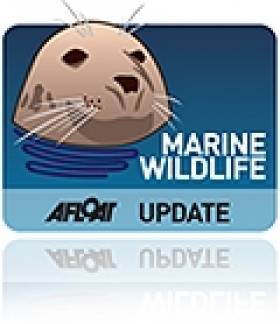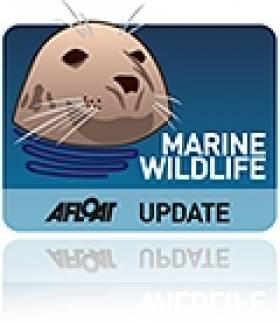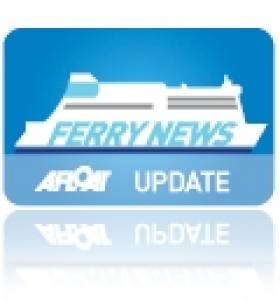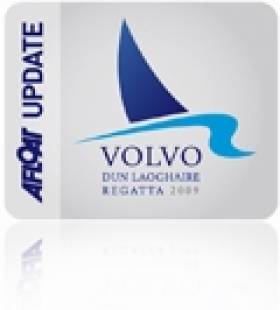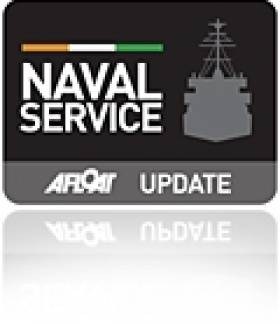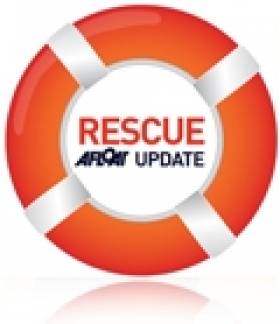Displaying items by tag: irish sea
Sonar Survey Reveals Torpedoed Guinness Ship
The detailed seabed images, which include deck features and complex sand wave structures, were recorded by towed sidescan sonar provided by the Moore Marine Group, and give a visual insight into the defensively armed ship that was sunk by a German torpedo in 1917, seven miles east of the Kish Bank off Dublin.

Photos above and below show topographic seafloor images in 3D, showing the partially buried wreck of the W M Barkley lying at a water depth of 56 metres; with deeper scouring around it down to 72 metres (darker colours indicate greater depths). The images were created from sonar data acquired onboard the Marine Institute's research vessel RV Celtic Voyager, during INFOMAR Programme mapping in 2010 and 2011 with data processed by INFOMAR's Fabio Sacchetti (University of Ulster) and Charise McKeon (Geological Survey of Ireland).

In May 2010, during a large scale mapping survey in the Irish Sea by INFOMAR, a national marine study run by the Marine Institute and the Geological Survey of Ireland, identified a seabed feature which, to the trained eye, was discernable as a potential shipwreck lying in the same position recorded on the Admiralty Chart, the EU wreck site and UK Hydrographic Office wreck site directories, as well as a survey conducted in the 1980s as the last known position of the W.M.Barkley.
Viewing the spectacular imagery of the shipwreck Minister for Communications, Energy & Natural Resources, Pat Rabbitte, said "I am delighted to note the continued excellence of the valuable work being carried out under the INFOMAR project. These images from the deep reveal a unique view of part of Ireland's marine heritage and I am delighted to announce details of INFOMAR''s annual seminar to be held in Galway on November 16 and 17th."
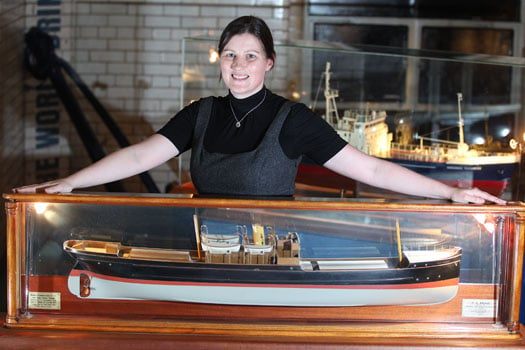
Eibhlin Roche - Guinness Archivist, Guinness Storehouse with the model of the W.M. Barkley. Photo: Jason Clarke Photography
Ninety four years ago on the dark night of October 12th 1917 the W.M.Barkley was torpedoed without warning by the German submarine UC-75. Within minutes the ship, which was owned and operated by the Guinness Company of Dublin, broke in two and sank, taking with her to the bottom four men including her Captain and leaving the rest of her crew to face the sea in an open lifeboat. Now, the darkness where the ship has lain in pieces has been disturbed, probed by fingers of sound that are mapping the seabed in incredible details and bringing to light the position of this famous Irish shipwreck.
"As the first Guinness owned ship, the W.M. Barkley played an important role in the story of the transportation of GUINNESS beer overseas," said Eibhlin Roche, Guinness Archivist. The events of the night of 12th October 1917 are very much part of the history of Guinness that is recorded in the Guinness Archive. It is exciting to finally know the exact resting place of the W.M. Barkley."
A scale model of the W.M. Barkley is on display in the Transport Gallery of Guinness Storehouse remembering the lives of the Guinness men who both perished and survived the events of 12th October 1917. These are stories of tragedy and bravery portraying Irish traditional values, and how they were brought to light with the application of cutting-edge technology.

Koen Verbruggen (GSI), Minister Pat Rabbitte, Dr. Peter Heffernan (CEO, Marine Institute), Eibhlin Roche (Guinness Archivist, Guinness Storehouse) and David Smith (Country Director, Diageo Ireland) Photo: Jason Clarke Photography
Proposals Unveiled for Marine Conservation Zones in England and Wales
Proposals to create more than 100 conservation zones to protect marine wildlife and plantlife in England and Wales have been unveiled.
BBC News reports that the proposals - covering waters around the English and Welsh coastlines, including parts of the Irish Sea - will be assessed by a panel of experts before a final decision by the British government, expected some time in 2012.
The Marine Conservation Zones (MCZs) will have differing levels of protection, depending on what regulators choose to prohibit and when under the provisions of the 2009 UK Marine Bill. This is to allow flexibility for activities such as fishing and recreation.
Should all proposals be approved, it would place more than a quarter of all English waters under some form of protection.
It is also hoped that this is the first step towards a network of protected waters across the whole of the UK.
Proposals for protection zones in Scotland are expected to come forward next year. Meanwhile, the Northern Ireland legisative assembly has yet to pass its own marine protection laws.
BBC News has more on the story HERE.
Welsh Keep a Look Out for Leatherback Turtles
Beachgoers in Wales have been urged to watch out for leatherback turtles who have come to the Irish Sea attracted by the rising numbers of jellyfish.
There have already been a dozen sightings of the endangered marine creatures off the UK coast this year, according to the Marine Conservation Society.
“There are so many jellyfish this year, with lots and lots of reports, particularly in the Irish Sea – it’s turtle heaven, there’s so much food for them,” said MSC biodiversity programme manager Dr Peter Richardson.
The society is hoping to identify any hotspots where they can run protective measures.
The leatherback turtle can grow up to 3m long as weigh as much as a tonne. They are often mistaken for floating logs, said Dr Richardson, but "once you see their large reptilian head, massive flippers and ridged leathery shell you can’t mistake them for anything else".
The Western Mail has more on the story HERE.
First Heysham-Max Newbuild Launched for Seatruck Ferries
The quartet of Heysham-Max class vessels are the largest ever vessels built to operate from the Cumbrian port which has determined the length of the new ships. Despite the restrictions imposed by the dimensions of the port, the optimum cargo-load of the newbuilds were achieved by positioning the deckhouse forward so to guarantee un-hampered loading of the upper decks.
Propulsion is from two MAN 7L48/60CR main engines of 2 x 8,000kW providing 21 knots. The powerplant is designed to meet rigorous emission and fuel consumption demands, according to FSG managing director Peter Sierk.
The intrepid travellers have come from such places as Limerick and Liverpool. Within the class, Ralph Roberts is a representative of the more adventurous. In the company of a most amazing crewman, Ralph sailed his dinghy from Liverpool to Dun Laoghaire, though he did break the journey with a short respite in Hollyhead.
During the trip, the highfield lever, a mechanism which controls the rig and the ability to sail to windward kept slipping which must have accounted for a considerable portion of his 23 hour journey time. Apparently the troublesome nature of this piece of kit on the boat is on par for the vintage and value of the boat in question. His fellow Wayfarer comrades, on hearing of his difficulties emptied their tool boxes and kindly supplied him with replacement parts. Upon receiving such bounty, he was heard to remark, 'For the return journey, we can now sail around Ireland.'
Apparently, a non stop circumnavigation of the island of Ireland is not beyond the boat's resources as one or other of the helm and crew can be ensconced in sleeping bags and be securely tied-in under the thwart. Indeed this, according to one, is how Ralph planned his accomodation for this Regatta.
This particular boat's name is 'Foxy Lady'. She can be seen swinging on a mooring on the East Bight area of the harbour. She didn't sail today. Perhaps the light airs and the relative short race-course are not enough of a challenge for her? Or maybe her crew are distracted in their perparations for an entry in the Vendee Globe. Well, it stands to reason doesn't it? The Barcelona Double Handed Round the World Race has already started and the next Round Ireland Race is not 'till next year.
The Vendee, being a single-handed only race, should release Ralph's Most Amazing Crew (M.A.C.) for more heroic duties on other boats. Should anyone with to avail of M.A.C's services, we will of course forward your application if it is suitably supported with a description of a similar Ralphesque type adventure.
Celtic Link Ferries First Ferry Goes to the Breakers
Launched as the Stena Tranporter, the career of the 16,000 tonnes has spanned over three decades in which the 151m vessel changed through several owners and subsequent vessel renamings.
It was when she served under the name Baltic Ferry, that her most notable career took place in 1982 during her wartime deployment as part of the
Falklands Islands Task Force. The 151m vessel was requisitioned by the British Ministry of Defence which saw the ship engaged in military operations when RAF Harrier Jump-Jet aircraft transferred store supplies from the deck of the ship as part of the war-effort in the South Atlantic Ocean.
In 2001 the vessel undertook ferry operations to Ireland as the European Diplomat on the Dublin-Liverpool route for the P&O (Irish Sea) route network. The following year she was transferred on the direct route to France until P&O pulled the plug on the continental service in December 2004, leaving Irish Ferries as the sole operator.
It was not until February 2005 that the route resumed service but this time under new owners Celtic Link Ferries. The O'Flaherty brothers, owners of a large fishing fleet in Kilmore Quay purchased the vessel and renamed her Diplomat. See PHOTO.
For the next four years she built up a steady customer loyalty between freight-hauliers drivers and car-only accompanying passengers who were accommodated in the ship which had a limited passenger certificate for 114 passengers. In addition she had a license to transport livestock.
Currently Celtic Link Ferries operate the ferry Norman Voyager but the 800-passenger / 200-car ro-pax vessel will only remain on the route until an October debut of a larger sistership the Cartour Beta.
The vessel is running this season between Italy and Sicily and with an added deck the 27,552 tonnes vessel has an increased capacity for passengers, cars and enhanced range of facilities. Recently the company had run a competition to name the new vessel which is to begin a five-year charter on the service between Wexford and Normandy.
- Wexford
- irish sea
- Diplomat
- Celtic Link Ferries
- Kilmore Quay
- Stena Rederi
- Marine Express
- RosslareCherbourg
- Norman Voyager
- Ports and Shipping News
- Normandy
- RoPax
- DublinLiverpool
- P&O (Irish Sea)
- Ferry news
- Cartour Beta
- Irish Sea Ferries
- Stena Transporter
- Baltic Ferry
- European Diplomat
- O'Flaherty Brothers
- Falklands Islands Task Force
- Hyundai Heavy Industries
- Freighthauliers
- Livestock
- RAF
- Harrier JumpJets
The operation was spearheaded by the ARW with the support of a Naval Service coastal patrol vessel (CPV) and also Air Corps helicopters. High-speed tactical assault craft with ARW teams on board conducted manoeuvres while air-borne teams fast-roped from helicopters onto the deck of the Stena Adventurer. To see photos of the ARW team in action click HERE.
The exercise was designed to enhance the capacity of the Defence Forces to provide the State with a highly specialised maritime armed intervention capability.
Last month the Naval Service conducted close quarter manoeuvres in 'Operation Quixote' off the south-west coast. The exercise involved the entire naval fleet except for the flagship LE Eithne, which performed in gunnery practice, simulated air attacks from the Air Corps and armed naval boarding parties.
Rescue Alert Over Trawler Mayday in Irish Sea
The News & Star reports that RNLI Workington responded to the fishermen's mayday call along with Maryport's coastguard and inshore rescue team.
Engline failure is being blamed for the incident, which occurred before 9.30am on Monday morning. The trawler has since been towed to Ireland for repairs.
Raging Bull Charges Back to Top of ISORA Fleet
After missing the last ISORA race the 2010 Champion Raging Bull charged back to the front of yesterday's 7-boat fleet in a blustery offshore race across the Irish Sea from Pwlhelli in Wales to Wicklow harbour on the Irish East coast. Second to Matt Davis's Sigma 400 was the Welsh J109 Sgrech and third the Royal Irish A35 entry Aztec III skippered by Peter Beamish.
The bad weather before the race and difficulties with delivery as well as a general poor forecast (and a rugby match) for the race was the
main reasons for a very disappointing turn out for what is normally a very popular race.
Some of the fleet – now moored in Wicklow harbour – are sailing in this morning's Round the Turbines race from nearby Arklow Sailing Club. Provisional ISORA results from the Pwllheli to Wicklow race are below.
ISORA interests now turn to the big offshore fixture of the season, the Dun Laoghaire to Dingle Race on Saturday, June 11th.
Scroll down for Race start pics by Cathy Mullan| Boat Name | Sail No. | Type | IRC Rating | IRC | Finish Time | Time elapsed | Time elapsed | Corrected | Corrected | Place | Place |
|---|---|---|---|---|---|---|---|---|---|---|---|
| (provisional) | No Spinnaker | Time | Time | Class | O/A | ||||||
| English Mick | GBR4771R | Beneteau 47.7 | 1.127 | IRC | 18:43:20 | 37700 | 10:28:20 | 42487 | 11:48:07 | 2 | 7 |
| Quite Correct | IRL 5405 | DS54 | 1.095 | IRC | DNS | - | - | - | - | - | - |
| African Challenge | IRL 2649 | Fast 42 | 1.077 | IRC | DNS | - | - | - | - | - | - |
| Tsunami | IRL 4007 | First 40.7 | 1.061 | IRC | 18:54:19 | 38359 | 10:39:19 | 40698 | 11:18:18 | 1 | 5 |
| Lancastrian | GBR 7682T | Starlight 14.5m | 1.059 | IRC | DNS | - | - | - | - | - | - |
| Rebellion | IRL 6001 | Nicholson 58 | 1.054 | IRC | DNS | - | - | - | - | - | - |
| Orna | IRL 532 | 1.042 | IRC | DNS | - | - | - | - | - | - | |
| Aztec 3 | IRL29832 | A35 | 1.034 | IRC | 18:59:14 | 38654 | 10:44:14 | 39968 | 11:06:08 | 3 | 3 |
| Jedi | IRL 8088 | J109 | 1.029 | IRC | 19:04:01 | 38941 | 10:49:01 | 40070 | 11:07:50 | 4 | 4 |
| Raging Bull | IRL 9666 | Sigma 400 | 1.027 | IRC | 18:57:47 | 38567 | 10:42:47 | 39608 | 11:00:08 | 1 | 1 |
| Miss Scarlett | IRL 4763 | Sunfast 40.3 | 1.025 | IRC | DNS | - | - | - | - | - | - |
| Sgrech | GBR9319R | J109 | 1.021 | IRC | 19:03:00 | 38880 | 10:48:00 | 39696 | 11:01:36 | 2 | 2 |
| Lula Belle | IRL 3607 | First 36.7 | 1.019 | IRC | 19:51:46 | 41806 | 11:36:46 | 42600 | 11:50:00 | 5 | 8 |
| First of September | IRL 8581 | First 43.5 | 1.016 | IRC | 20:47:59 | 45179 | 12:32:59 | 45901 | 12:45:01 | 7 | 12 |
| Dinah | IRL 3508 | JOD 35 | 1.016 | IRC | 20:04:31 | 42571 | 11:49:31 | 43252 | 12:00:52 | 6 | 9 |
| Windshift | IRL 37737 | SF37 | 0.992 | IRC | DNS | - | - | - | - | - | - |
| Adelie | FRA 9631 | First 34.7 | 0.988 | IRC | 20:52:02 | 45422 | 12:37:02 | 44876 | 12:27:56 | 2 | 10 |
| Mojito | GBR 1536L | Bravaria 39 | 0.988 | IRC | 19:52:14 | 41834 | 11:37:14 | 41331 | 11:28:51 | 1 | 6 |
| Mistral of St Helier | K 8337 | Sigma 38 | 0.984 | IRC | 21:08:39 | 46419 | 12:53:39 | 45676 | 12:41:16 | 3 | 11 |
| Yahtzee | IRL 1068 | Oceanis 411 | 0.983 | IRC | 21:35:25 | 48025 | 13:20:25 | 47208 | 13:06:48 | 4 | 13 |
| Sarnia | IRL 2260 | 0.891 | IRC | DNS | - | - | - | - | - | - |
Lively Lady is ISORA Rockabill Race Winner
East Coast inshore campaigner Lively Lady (Derek Martin) left Dublin Bay racing behind yesterday for ISORA's offshore race to Rockaill and won. The Royal Irish boat, a Beneteau First 44.7, topped a 13-boat fleet over the 50 mile course to Rockabill. It was the second ISORA race of the 2011 calendar.
Second overall was another Beneteau, Walter Mitty, Stephen Mullaney's First 375 from Howth Yacht Club. Third was Jedi, Andrew Sarratt's J109 from Dun Laoghaire.
Yesterday's race was a much more pleasant start to the season compared to the previous weekend's pasting taken during the slog across the Irish Sea to Holyhead. Perhaps that was the reason for the drop off in entries from 21 to 13? Next Saturday's ISORA fixture features another cross Irish Sea venture, this time to Pwhelli.
Race two results are available for download below. Latest ISORA news here.
ISORA Commodore Peter Ryan adds:
It had been hoped that there would be a bumper fleet out for this popular day race run in conjunction with the Royal Alfred Yacht Club and the Lee Overlay Offshore Series but despite 25 entries, only 15 came to the start line. The heavy offshore race to Holyhead and delivery back the previous weekend and the strong winds all the week since then, had taken its toll with damage to boats and crew and boats not being to get to Dun Laoghaire.The weather forecast for the day was for wind force 3-5 south east going east. The original course was to go south to North Arklow buoy. However, with the strong spring tides going north at the start and the light winds forecast, the Sailing Committee decided that going north to Rockabill would ensure a finish would be achieved to all boats. The course was: Start – North Burford(P) – Lambay (P) – Rockabill (S) – Lambay (S) – Kish Light (S) – Finish at Dun Laoghaire Harbour (45 miles).
Paul McCarthy of the RAYC provided the start at 10.00 and the fleet set off on a white sail reach towards North Burford. The wind was as forecast, south east force 3-4. Rounding that mark, spinnakers were raised and the fleet sped north with the tide. Shorthy after 12.00 “Lively Lady” rounded Rockabill followed by “English Mick”, “Orna” and directly behind her “Tsunami”.
The leg back to Kish was a beat keeping Lambay to starboard. The wind fluctuated with the stronger wind being out to sea. Most boats tacked behind Lambay to get the benefit of some lack tides in the lee of the island.
The wind was holding as the fleet neared Kish. First round was “Lively Lady” followed by “English Mick”, “Tsunami”, “Orna” and “Jedi”. As forecast the wind backed to east and dropped. What was looking like a charge to the finish turned out to be a crawl. Many of the boats at the back of the fleet gained by a temporary filling of the wind from behind as they caught up with the leading pack. However, “Lively Lady” and “English Mick” held their positions and crossed the line first and second. “Jedi” and “Orna” crept past “Tsunami” to cross the finish.
“Lively Lady” took line honours, 1st in Class and 1st Overall. “Jedi” took 1st in Class 2 while “Walter Mitty” won Class 3.
Sandra Moore of the NYC provided the finish. The usual après sail took place in the NYC after the race.
The next race is the Day Race in Pwllheli on the 14th May. It is hoped that the day race there will attract some new entrants from the Welsh side.
| Rank | Fleet | Boat | SailNo | Type | Rating | Start | Finish | Elapsed | Corrected | Points |
|---|---|---|---|---|---|---|---|---|---|---|
| 1 | Class 1 | Lively Lady | IRL 1644 | First 44.7 | 1.109 | 10.00.00 | 16:21:00 | 6.21.00 | 7.02.32 | 98.6 |
| 2 | Class 3 | Walter Mitty | IRL 7963 | First 375 | 0.947 | 10.00.00 | 17:36:38 | 7.36.38 | 7.12.26 | 92.8 |
| 3 | Class 2 | Jedi | IRL 8088 | J109 | 1.029 | 10.00.00 | 17:05:15 | 7.05.15 | 7.17.35 | 87.0 |
| 4 | Class 1 | Orna | IRL 532 | 1.047 | 10.00.00 | 17:13:18 | 7.13.18 | 7.33.40 | 81.2 | |
| 5 | Class 2 | Lula Belle | IRL 3607 | First 36.7 | 1.019 | 10.00.00 | 17:28:55 | 7.28.55 | 7.37.27 | 75.4 |
| 6 | Class 3 | Windshift | IRL 37737 | SF37 | 0.992 | 10.00.00 | 17:41:59 | 7.41.59 | 7.38.17 | 69.6 |
| 7 | Class 2 | First of September | IRL 8581 | First 43.5 | 1.017 | 10.00.00 | 17:32:41 | 7.32.41 | 7.40.23 | 63.9 |
| 8 | Class 1 | Tsunami | IRL 4007 | First 40.7 | 1.061 | 10.00.00 | 17:15:00 | 7.15.00 | 7.41.32 | 58.1 |
| 9 | Class 1 | English Mick | GBR4771R | Beneteau 47.7 | 1.130 | 10.00.00 | 16:50:07 | 6.50.07 | 7.43.26 | 52.3 |
| 10 | Class 2 | Miss Scarlett | IRL 4763 | Sunfast 40.3 | 1.025 | 10.00.00 | 17:33:06 | 7.33.06 | 7.44.26 | 46.5 |
| 11 | Class 3 | Yahtzee | IRL 1068 | Oceanis 411 | 0.983 | 10.00.00 | 17:57:51 | 7.57.51 | 7.49.44 | 40.7 |
| 12 | Class 1 | Sailing West Intuition | GBR 9383 | Reflex 38 | 1.060 | 10.00.00 | 17:28:33 | 7.28.33 | 7.55.28 | 34.9 |
| 13 | Class 1 | Rebellion | IRL 6001 | Nicholson 58 | 1.054 | 10.00.00 | 17:39:22 | 7.39.22 | 8.04.10 | 29.1 |
| 14 | Class 1 | African Challenge | IRL 2649 | Fast 42 | 1.077 | 10.00.00 | 17:33:11 | 7.33.11 | 8.08.05 | 23.4 |
| 15 | Class 3 | Obsession | IRL4513 | Sigma 33 | 0.905 | DNF | 10.0 |



























